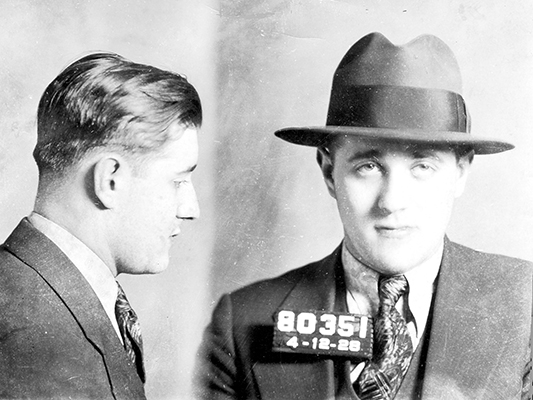Benjamin “Bugsy” Siegel

Born: February 28, 1906, Brooklyn, New York
Died: June 20, 1947, Beverly Hills, California
Nicknames: Bugsy, Bugs, Benny
Associations: Meyer Lansky, Charlie “Lucky” Luciano, Murder Incorporated, George Raft, Virginia Hill, Mickey Cohen
Benjamin “Bugsy” Siegel rose from the rough streets of New York City to the height of fame and fortune in sunny Southern California, but his violent death helped expose the dark side of Mob life. Although his life was cut short at age 41, he played a pivotal role in building modern Las Vegas.
The son of Jewish immigrants, Siegel was raised in the crime-ridden section of Williamsburg, Brooklyn, where ethnically divided youth gangs and adult racketeers were pervasive elements of the community. As a young man, he reportedly extorted protection money from pushcart peddlers on the other side of the East River, in New York City’s Lower East Side, where, in 1918, he befriended Meyer Lansky, another tough Jewish kid, with whom he established the Bugs and Meyer Gang.
“Fellow gang members nicknamed Siegel ‘Bugsy’ in reference to his notoriously quick and violent temper — he was as ‘crazy as a bedbug,’” reported PBS in its documentary, Las Vegas: An Unconventional History.
During the early 1930s, Mafia kingpin Charles “Lucky” Luciano and other Italian gangsters organized themselves into a New York regional, then later national, Syndicate. Luciano’s enemies had a tendency to expire violently, and Siegel graduated from the Bugs and Meyer organization to work for Luciano. Many writers on these early years of organized crime have tied Siegel to the execution of Luciano rival Joe “the Boss” Masseria in 1931, a notable chapter in the brutal Castellammarese Wars that ripped up metropolitan New York City in the latter years of Prohibition. Reports have four men, including Siegel, shooting Masseria after the Mob boss ate a large pasta meal in a restaurant.
However, as historian Larry Gragg of the Missouri University of Science and Technology has documented, there are some problems with this story. First, contemporary witnesses said there were two shooters, an autopsy said Masseria had an empty stomach, and it wasn’t until later that Siegel, who had garnered a reputation for violence, was linked to the killing. Or, for that matter, to the execution of another Mob boss (and the last real rival to Luciano), Salvatore Maranzano, later that year.
That doesn’t mean Siegel wasn’t involved, or that he wasn’t a gunman in either case, but his reputation was such that he was tied to violent events and crimes in which he may not have participated. (One writer attempted to pin the infamous “Black Dahlia” murder in Los Angeles in January 1947 on Siegel, despite the fact that Siegel at that time was being closely watched by the FBI, and his activities on the day of the murder were fully accounted for.) So, it’s possible Siegel may not have been a murderous monster as some have described him.
He was, however, clearly an associate of Lansky, of Luciano, and of other New York City mobsters, including the nucleus of “Murder Incorporated,” the enforcement-through-murder-and-intimidation arm of Luciano’s criminal syndicate. And in New York, police were watching Siegel closely, which reportedly is why, in 1936, Lansky suggested that his friend relocate to the West Coast.
There, Siegel helped build the rackets in the swiftly growing communities of Southern California. Along with mobsters such as Mickey Cohen, Siegel set up gambling dens and offshore gambling ships, while consolidating the already existing prostitution, narcotics and bookmaking operations. He made deals to bring the race wire to California, helping to distribute critical gambling information to and from the West Coast.
His wealth carried him further in California than his criminal reputation had on the East Coast. He was able to buy a large home in swank Beverly Hills, to frequent parties of the Hollywood elite and to maintain friendships with movie stars. His close friends included George Raft, an actor and dancer who was born in New York City of immigrant parents and who associated with mobsters as he was growing up.
Raft, who had moved to Hollywood in 1929 and became famous appearing in gangster movies, apparently served as a significant interlocutor between Siegel and other Hollywood personalities. Raft also served as a character witness during one of Siegel’s criminal trials.
In the late 1930s, Siegel began dating actress Virginia Hill. They were a striking couple, known as much for their volatile natures as for their glamorous looks. In 1945, Siegel, with Hill at his side, took over construction of a hotel-casino on the edge of Las Vegas.
Siegel wasn’t the first entrepreneur to envision something fabulous in the desert, but his dream elevated the stakes. The Flamingo Hotel construction was financed mostly by Eastern crime syndicate bosses under Siegel’s direction.
But the project did not go well. Originally budgeted at $1.2 million, construction costs soared to $6 million, enraging Siegel’s mobster financiers.
On the evening of June 20, 1947, a hail of gunfire crashed through Hill’s living room window in Beverly Hills, killing Siegel. Literally minutes later, three associates of Lansky entered the Flamingo and announced that they were in charge. Although Lansky denied involvement in the murder, one theory is that it was a syndicate-approved hit.
But it’s not the only theory. Another theory asserts that Siegel was targeted by Virginia Hill’s brother because of a history of domestic confrontations between the couple. Another is that Moe Sedway – one of the three Lansky associates who took over the Flamingo – was involved in a love triangle into which Siegel stumbled.
But in any event, Siegel was shot multiple times, including two fatal head wounds, with .30-caliber bullets. His death has never been solved.
The Mob Museum hosted a Courtroom Conversation in March 2015 on the mystery behind Siegel’s murder. Watch it below:




